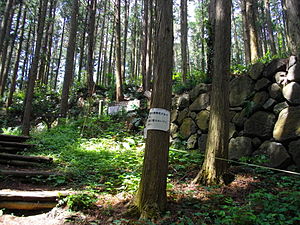Karasuyama Castle
| Karasuyama Castle | ||
|---|---|---|
|
Karasuyama, castle ruins |
||
| Alternative name (s): | Gojō-Sankaku | |
| Creation time : | 1418? | |
| Castle type : | Yamajiro (mountain castle) | |
| Place: | Nasukarasuyama | |
| Geographical location | 36 ° 39 '50 " N , 140 ° 8' 51" E | |
|
|
||
The castle Karasuyama ( Japanese 烏山城 , Karasuyama-jō ) is located in the city Nasukarasuyama , in Tochigi Prefecture . In the Edo period , a branch of the Ōkubo resided there as Fudai daimyō .
Lords of the castle in the Edo period
- From 1616 the Narita with an income of 37,000 Koku ,
- from 1627 a branch of the Hori with 25,000 koku,
- from 1672 a branch of Itakura with 50,000 koku,
- from 1681 the Nasu with 30,000 Koku,
- from 1687 a branch of the Nagai with 30,000 koku,
- from 1702 a branch of the Inagaki with 25,000 Koku,
- from 1725 a branch of the Ōkubo with 20,000 koku.
history
In 1418, Nasu Sukeshige ( 那 須 資 重 ) is said to have built a small castle on the western bank of the Nakagawa (那 珂川) on the hill Hakkō-san ( 八 高山 ). The Nasu resided there since the 15th century.
In 1590 Toyotomi Hideyoshi took the area from the current lord of the castle, Nasu Sukeharu ( 那 須 資 春 ) and gave the castle to the Narita. It was followed by other different daimyo, including once again the Nasu, until Ōkubo Tsuneharu ( 大 久保 常春 ; 1675-1728) 1725 took over the castle. The Ōkubo remained lords of the castle until the Meiji restoration .
The attachment
The castle was usually called "five-fortress-triple bailey" ( 五 城 ・ 三 郭 , Gojō-Sankaku ) because it consists of the central area, the Hommaru ( 本 丸 ; 1), the old Hommaru ( 古 本 丸 , Kyū-hommaru ; 1a) , the middle castle ( 中 城 , Nakajiro ; B), the north castle ( 北 城 , Kitajiro ; C) and the western castle ( 西城 , Nishijiro ; D), supplemented by the outer castles Wakasa-kuruwa ( 若 狭 曲 輪 ; W), Tokiwa-kuruwa ( 常 盤 曲 輪 ; T) and Ōno-kuruwa ( 大野 曲 輪 ; O).
The main entrance to the castle was via the "Seven Bends Way" ( 七 曲 口 , Nana-magari-guchi ) to a fortification called Taiko-maru ( 太 鼓 丸 ), in which the drum tower ( 太 鼓楼 , Taiko-rō ; F) found. Then we continued over the Kurumabashi Bridge ( 車橋 ; E) through the Tokiwa Gate ( 常 盤 門 ) up to the castle. Another access in the northeast was via the "Twelve Bends Way" ( 十二 曲 口 , Jūni-magari-guchi ) up, then past the castle fountain (Q) to the castle. At the foot of the mountain was the fortified San-no-maru ( 三 の 丸 ; 3) with the residence in the later years .
Today the castle grounds are largely covered by forest. In their footsteps, however, the castle is still a good example of a medieval mountain castle.
Remarks
- ↑ With Narita Ujimune ( 成 田 氏 宗 ; † 1622) this clan died out.
literature
- Sugai, Yasuo: Karasuyama-jo in: Miura, Masayuki (Ed.): Shiro to jinya. Tokoku-hen. Gakken, 2006. ISBN 978-4-05-604378-5 , p. 58.
- Nishigaya, Yasuhiro (Ed.): Karasuyama-jo. In: Nihon meijo zukan, Rikogaku-sha, 1993. ISBN 4-8445-3017-8 .


